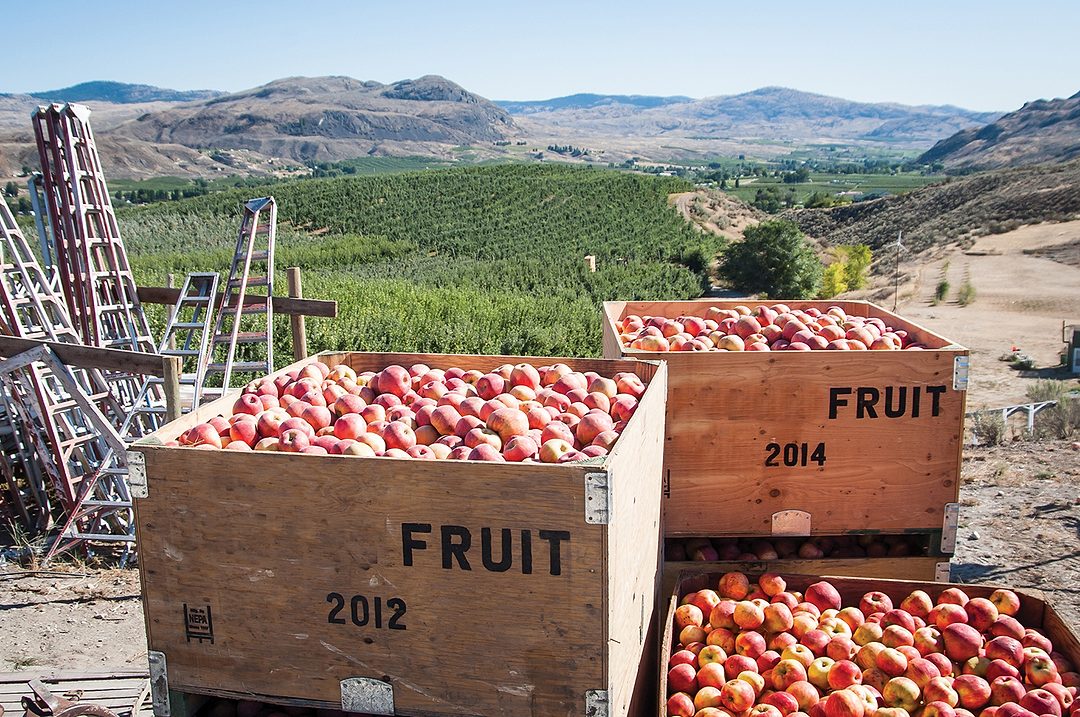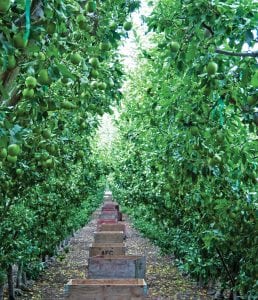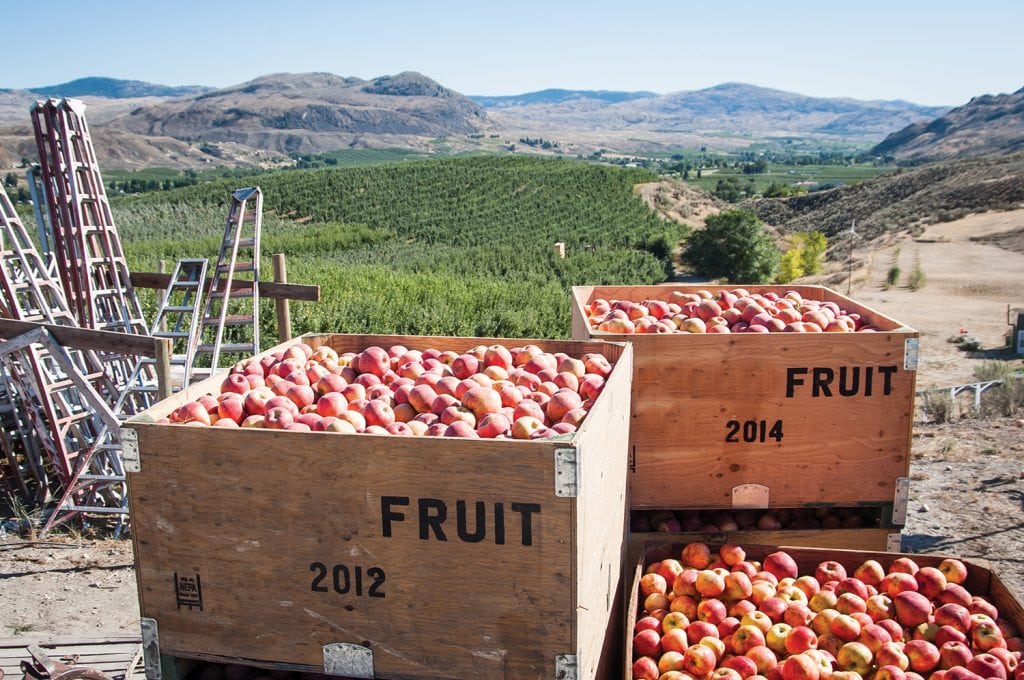
Home » Apple capital: State sends fruit to more than 60 countries
Apple capital: State sends fruit to more than 60 countries

May 6, 2018
Washington’s $3 billion apple industry is not just the state’s biggest crop, but it also accounts for two-thirds of total U.S. apple production.
Proactive international marketing campaigns, coupled with intensive breeding programs, are key factors in making the state the nation’s apple capital.
Washington’s “nutrient-rich soil, an arid climate, plentiful water and advanced growing practices provide the right ingredients for producing top-quality fruit,” according to the Washington Apple Commission.
Eastern Washington also offers room to expand, where the more developed, competing states of New York and Michigan do not, said Todd Fryhover, commission president.
Some 1,700 growers with orchards averaging 100 acres in size make up Washington’s industry, contributing to the production of about 130 million, 40-pound boxes, or 10 to 12 billion individual apples, annually, which equates to about 3 percent of international production, Fryhover said.
Though it might not sound like much market share, Washington exports one-third of its apples to more than 60 countries around the world.
“We really are dependent on international trade. … Our No. 1 objective is to promote Washington apples in foreign countries to assist in pulling the product through the marketplace,” said Fryhover, who said Washington has an $8 million international marketing budget.
“We have 11 reps around the world running promotional and marketing concepts within their countries to assist importers, wholesalers and retailers,” he said.
Canada and Mexico take the top spots for U.S. export markets, with the third and fourth spots being India and Taiwan, Fryhover said.
At Pasco-based Douglas Fruit, a family-owned orchard and packing house operation that serves 25 other orchards in the area, co-owner Jill Douglas said the company exports about one-quarter of its apples.
“Can’t complain; the market movement is pretty good. We have good export markets. … India and Taiwan have been great to us,” Douglas said.

Fryhover said Asia and the Middle East present new market opportunities, especially thanks to the proximity of Washington’s growing region to ports in Seattle and Tacoma, the gateway to the Pacific.
“When we look at the world, we see Asia as value-plus markets. Places like China are where we’re focusing our attention; Vietnam is another place, along with Indonesia,” Fryhover said.
China is responsible for 45 percent of the world’s apple production, with two billion bushels harvested this past year, versus 139 million bushels produced in the U.S.
“Every day we’re fighting to get access, maintain access and expand on that access,” Fryhover said.
The European Union remains a tough market to enter due to its high level of production. Despite having a smaller population than the U.S., the region produces three times as much volume.
Additional opportunities are being explored in South and Central America as well. “We are competitors out there in a very crowded marketplace,” Fryhover said.
A common theme across international markets is the introduction of new apple varieties tailored to consumer tastes.
Fryhover said consumers are beginning to show a preference for the new apples on the block over old standbys.
Eight varieties have made up 97 percent of Washington’s orchards for decades, out of the 2,500 or so known domestic varieties and 7,500 distinct breeds grown worldwide.
Innovations in DNA sequencing and other advancements in apple breeding science are fast-tracking the birth of new varieties.
One of these is the Cosmic Crisp, a “sweet and tangy” crossbreed between the Enterprise and Honeycrisp varieties developed and patented by Washington State University’s apple breeding program. It will be made exclusively available for 10 years to all Washington growers starting in 2019.
Some Cosmic Crisps will become available in retail stores next year.
“Cosmic Crisp has a dense cell structure, so the apples have a firm palette texture. No one is interested in eating a soft apple,” Fryhover said.
Another focus of breeding programs is the development of higher density varieties.
“There’s been a movement away from the traditional 400 trees per acre,” Fryhover said. “We’re now seeing (thousands of) trees per acre. … We’re seeing continued growth; new planting is going in annually.”
Another trend is expansion into organics. With consumer demand on the rise for organic produce, growers are responding.
“We’ve converted all of our stone fruit to organic, and have converted a lot of apples to organic from conventional,” Douglas said. “The organic market’s been growing at a pretty steady pace and the demand’s there.”
Douglas said Douglas Fruit has been growing organics for about 11 years. “We’re converting some of our best (apple) varieties and orchards to organic,” she said.
Washington Apple Commission officials report more than 25 percent of apple packers in the state hold organic handlers’ certificates and that Eastern Washington’s “dry climate and ideal temperatures reduce the number of disease and pest problems,” aiding the cultivation of organic produce.
“It costs more to grow it, no doubt about it,” Douglas said. “But … people have a choice and we’re giving them that choice.”

Like others in the agricultural sector, apple growers and packers are feeling the pressure of increasing production costs, primarily due to the scarcity and rising cost of labor.
“It’s our No. 1 issue by far and largest constraint by far,” Fryhover said.
All Washington apples are picked by hand. This is not only due to the stringent quality and grading standards Washington enforces, which are stricter than others used throughout the world, but because there aren’t machines for harvesting apples, he said.
Fryhover said the industry-wide crusade for higher-yielding apple varieties is directly linked to the issue of labor.
“There are only two things growers can control: the amount of product and the yield per acre,” Fryhover said.
“We’ve been here 30 years,” Douglas said. “And the last year (to) year and a half have been the toughest ever. … We’ve had high turnover, which usually is no problem at packing plants. … We have more jobs available, but the people just aren’t there.”
Douglas said Douglas Fruit uses the U.S. Department of Labor’s H-2A program to acquire enough workers to get them through all seasons. She said the company needs a consistent labor force all year long.
Douglas Fruit’s workers arrived March 15. “We’re bringing them in (one to two months) earlier than last year. … They will work all through harvest,” Douglas said.
“It takes 60,000 people to harvest the apple crop in Washington. Fifteen to 20 percent come through (H-2A),” Fryhover said. “We’re still heavily reliant on transitory labor. … Someone who is proficient can very easily make $150 to $200 per day.”
He said typical U.S. workers don’t like the difficult physical labor and that it’s seasonal work.
“Smaller farms can’t (afford to do H-2A) though; it doesn’t make sense, and (their crops are) often not diversified, so it’s very difficult,” Douglas said.
“All costs have gone up,” Fryhover said. “Even at minimum wage, we can’t even remotely compete.”
One of the growers Douglas Fruit works with is Denny Hayden of Hayden Farms in Pasco.
“The capital costs are tremendously high on developing any orchard right now; it’s $25,000 to $40,000 per acre just to establish it,” he said.
“This is not corporate America, it’s families that run these organizations,” Fryhover said. “This is a default system, not a preference. … Could there be a better solution? Absolutely. We’ve been asking for a better solution for a long time and haven’t gotten one.”
As the region prepares for the upcoming season, Douglas said the apples are on schedule for this year’s harvest, though she said there are still “a couple months of weather to get through to be in the safe zone.”
“The state of Washington is still one of the best places in the world to grow apples,” she said. “Hopefully we’re going to be in business a long time.”
Agriculture + Viticulture
KEYWORDS focus agriculture viticulture 2018





